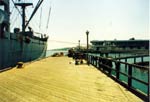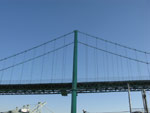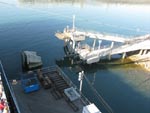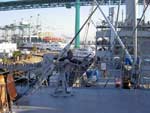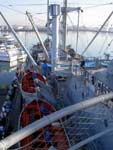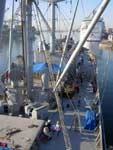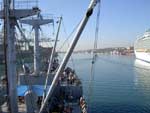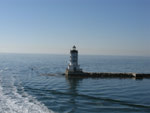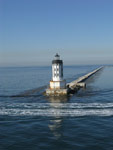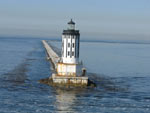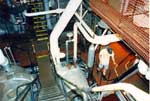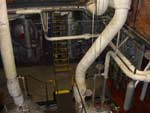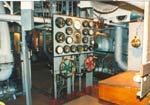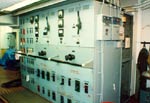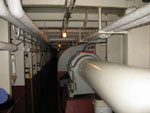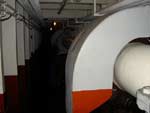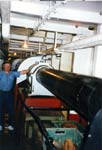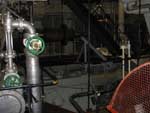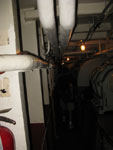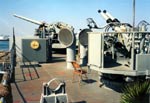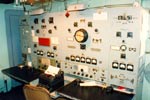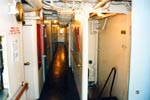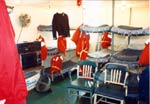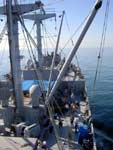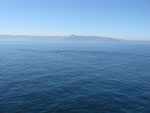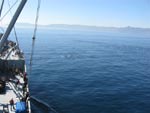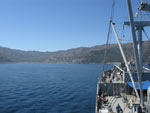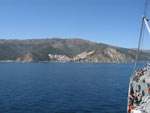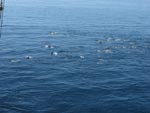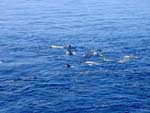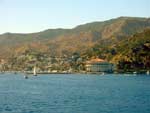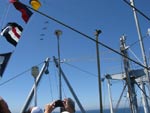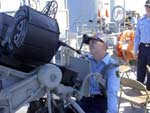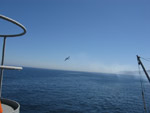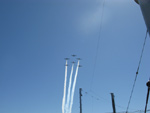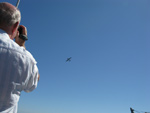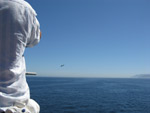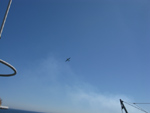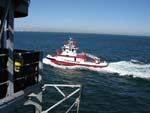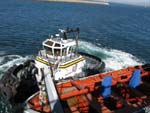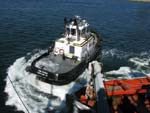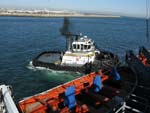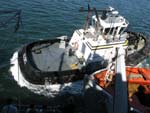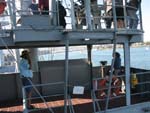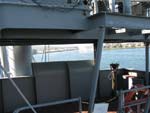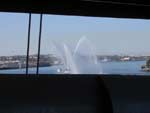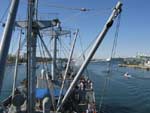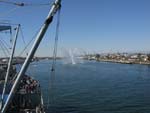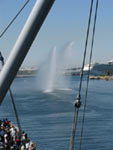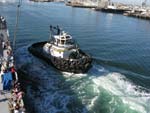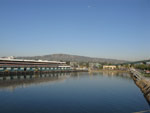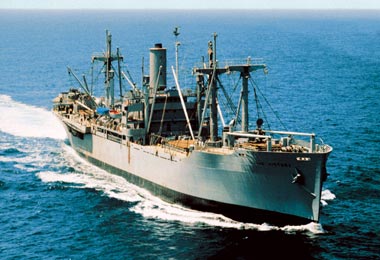 |
The S.S. Lane Victory is a United States Merchant Marine vessel built by California Shipbuilding Company, in Los Angeles, California and launched in May 1945. It is the last original, unmodified and fully operational VC-2S-APC type merchant transport vessel of the WWII era - one of 534 Victory class ships built between the years 1942-1945. It is currently berthed at Pier 94, Port of Los Angeles, in the City of San Pedro.
During World War II, Victory ships participated in the battles of Okinawa, Iwo Jima, and the occupation of the Japanese mainland. From 1945 to 1947 the Lane Victory carried troops and supplies to Japan and other South Pacific ports. Mothballed in 1948, it was reactivated for Korean War service in 1950. The ship took part in evacuation of US Marines from Wonsan Harbor, North Korea, carrying troops, supplies, and also participating in the historic evacuation of 7,000 refugees in one voyage in June 1950, from North Korea to Pusan, South Korea. After being placed back in storage until 1965, the ship was once again called to military service to transport supplies to Southeast Asia. Between 1966 and 1971, Lane Victory logged six voyages to South Vietnam in support of combat operations between 1966 and 1971. The ship was deactivated to the Navy Ready Reserve in 1971, pending being scrapped.
In June, 1988, the U.S. Merchant Marine Veterans of WWII obtained title to the vessel via an Act of Congress and Presidential Order by President Reagan. Work began to restore it as a living memorial to honor the nearly eight thousand merchant marine seamen lost in WWII. The ship was towed to the Port of Los Angeles where dedicated volunteers began extensive restoration work to attain operational status. This effort culminated in June, 1990, when the S.S. Lane Victory was declared a National Historic Landmark.
The United States War Shipping Administration commissioned the design of a cargo ship with a waterline length between 400 and 450 feet, steam propulsion and with one propeller in February 1942. Officially designated a Victory Ship on 28 April 1943. They were an enhancement of the previous Liberty ship design that was produced in much greater numbers having a higher speed of 15 to 17 knots and longer range compared to the Liberty ship's 11 knots. The higher speed was important because it made them less easy prey to U-boats, and was achieved by using improved engines over the Liberty's triple expansion reciprocating steam engine to the more modern, faster steam turbine engines with a power output between 6,000 and 8,500 horsepower. They also had electrically powered auxiliary equipment rather than steam powered in addition to strengthened hulls compared to Liberty ships.
The Victory ships were armed with a 5 inch stern gun for use against submarines, a bow-mounted 3 inch anti-aircraft gun and eight 20 mm cannon, also for use against aircraft. These weapons were manned by United States Naval Armed Guard personnel, members of the United States Navy.
The Unknown Service
About 8,300 seamen were killed at sea, 12,000 wounded of whom at least 1,100 died from their wounds, and 663 men and women were taken prisoner. Some were blown to death, some incinerated, some drowned, some froze, and some starved. Sixty six died in Japanese prison camps or aboard ships while being transported to other camps. A total of thirty one ships vanished without a trace to a watery grave. One in 26 merchant mariners serving aboard merchant ships in World WW II died in the line of duty. Thus merchant mariners, all of whom were civilians, suffered the greatest percentage of war-related casualties and deaths than all other U.S. military services.
History can sometimes be very cruel. During World War II shipping casualties were kept secret to keep the information about enemy successes from the public and to continue to attract and keep mariners at sea. Newspapers carried essentially the same story each week: "Two medium-sized Allied ships sunk in the Atlantic ." In reality, the average for 1942 was 33 Allied ships sunk each week. As a result the general public then and now knows very little about the sacrifice these men made to the war effort.
